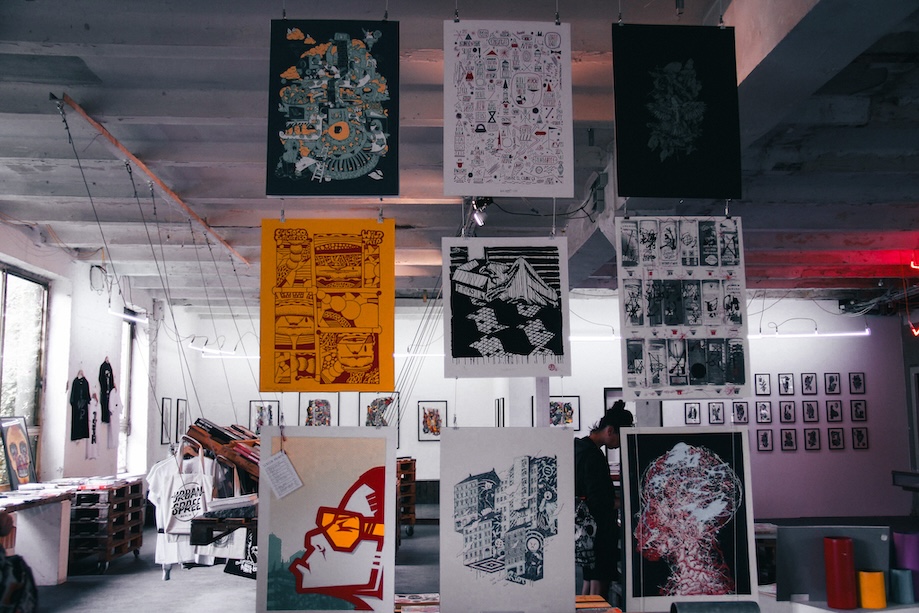A city renowned for its rich history and vibrant culture, Berlin offers a plethora of alternative and unusual museums that cater to traditional tastes.
“Poor but sexy.” This unofficial slogan of the city, coined by a former mayor, captures the essence of the atmosphere. Much of this sensuality stems from its alternative enclaves and vibrant cultural life. Berlin is a magnet for young artists, revolutionaries, and counterculture enthusiasts from various underground scenes.
In an interview with ‘Lado B,‘ Denis H, an artist, architect, and consultant at the art space Urban Nation, states that this phenomenon, which opened doors to alternative art in the city, is tied to its local history. There was a time when Berlin was a city where even Germans didn’t want to live. Full of empty spaces, abandoned buildings, and grey walls, it was occupied by artists who began to create there.
“It’s an incredibly exciting place, rich in history, freedom, and spaces where creativity can blossom. Moreover, the city’s rental prices and cost of living make it more appealing to artists’ wallets than other World capitals like London or New York.
This blog post journeys through some of Berlin’s most intriguing and lesser-known museums. From collections that challenge our perceptions to exhibits that highlight the obscure, these museums are not just about preserving the past but exploring the diverse narratives that shape our world.
Suggested Read:
• Best Places to See Street Art in Berlin
• Best Lakes to Swim in Berlin
• Teufelsberg: Visiting an Old Espionage Center in Berlin
10 Alternative Art Galleries and Unusual Museums To Go in Berlin
Now, let’s explore some museums and art galleries that will show you some of Berlin’s unusual side.
1. Urban Nation
urban-nation.com | Bülowstraße 97

“Create. Connect. Care”. Those words form the manifesto of the world’s first urban art museum foundation.
The institution seeks to transport street art into galleries and promote support for independent artists and graffiti artists so that they can find a hub for the dissemination of their work in the city.
2. Bethanien
bethanien.de |Toblerstrasse 51
An old hospital building in the hipster neighborhood of Kreuzberg has housed the Künstlerhaus Bethanien Art Museum and Center since 1975. The building was abandoned in the past, but it eventually transformed into a hub for disseminating artists and cultural and social trends.
The building houses galleries, space for shows and events, headquarters of various associations, and a museum, which offers workshops and courses with the artists who exhibit there. An annexed house, now a squat, once served as a base for the members of the RAF, the radical left-wing group that operated in Berlin until the 1990s.
3. Radial System
radialsystem.de | Holzmarktstraße, 33
Located within an old water station, Radial System is an art space that focuses not only on visual arts but also on other forms of expression, like music and dance.
It is situated across the River Spree, near the West Side Gallery, the most famous part of the Berlin Wall. It welcomes artists of all styles to combine tradition and innovation in the arts.
4. The Schwules Museum
www.schwulesmuseum.de | Lützowstraße 73
This is a groundbreaking institution dedicated to LGBTQ+ history and culture. Established in 1985, it is the world’s first museum dedicated to gay history. It boasts an extensive collection of periodicals dating from 1896, along with photographs, videos, films, sound recordings, autographs, artworks, and ephemera.
This site also became known as Homo-Hof (“the gay courtyard”) due to its housing of a gay nightclub, a gay-friendly café, and an LGBTQ+ rights support group.
The Schwules Museum hosts several temporary exhibitions annually, illuminating historical periods, developments, and key figures in LGBTQ+ history. These have included exhibitions on the gay rights movement, the persecution of homosexual men in Berlin during Nazi Germany, and collaborations with other museums showcasing a broad range of material on the history, politics, and culture of homosexuality.
5. DDR Museum
ddr-museum.de | Vera Britain Ufer, Karl-Liebknecht-Str. 1
This museum in Berlin offers a unique and immersive experience of the everyday life of socialist East Germany during the era of the Deutsche Demokratische Republik (DDR).
Upon entering the museum, visitors are transported into a different world, one that meticulously recreates the living spaces of East Germany. These exhibits are designed to be highly interactive, allowing visitors to experience the essence of life behind the Iron Curtain. You can walk through authentically furnished homes, including typical DDR living rooms and kitchens, with original artifacts from that time.
The museum also sheds light on the political and historical context of the era, providing a comprehensive understanding of the socialist regime. You can book your visit here.
6. Illuseum Berlin
www.illuseum-berlin.de | Karl-Liebknecht-Straße
Formerly known as the Museum of Illusions, this is a fascinating place in Berlin. Since its opening in August 2018, the museum has captivated visitors with its collection of 50 different illusions. This interactive space tests the human brain through optical illusions, games, and kaleidoscopes.
The visitors become part of the exhibition, bringing the illusions to life. The exhibits are designed not to confuse but to entertain both the eyes and the brain. They include a variety of optical illusions, holograms, and photographic illusions, along with thematic rooms featuring interesting installations such as “The Head on the Serving Plate,” “The Infinite Space,” and “The Chair Illusion.” You can book your visit here.
7. Museum of Musical Instruments
museumsportal-berlin.de | Ben-Gurion-Straße
This museum, dedicated to European art music, spans a vast timeline from the 16th to the 21st century. Its extensive collection includes about 3,300 instruments, with approximately 800 on display. Many of these instruments are not only historically significant but are also preserved in playable condition, allowing visitors not only to see but also hear the evolution of musical instruments.
The museum’s interactive approach, featuring listening stations and multimedia terminals, allows visitors to engage deeply with the history and sound of these instruments. From Baroque wind instruments to early synthesizers, the museum provides a comprehensive journey through the history of musical instrument development, making it a must-visit for anyone interested in the rich history of music.
8. Hanf Museum Berlin (Berlin Hemp Museum)
hanfmuseum.de | Mühlendamm 5
The Hanf Museum Berlin offers a comprehensive exploration of the versatility of hemp. This museum, the only one of its kind in Germany and one of the few in the world, covers an impressive 250 square meters dedicated to the agricultural, manufacturing, industrial, and legal aspects of hemp use.
The exhibition aims to present hemp’s numerous facets and significant historical contributions. It traces the journey from the plant’s cultivation to its varied applications in insulation, textile and paper manufacturing, and even cosmetics and pharmaceuticals.
Hemp’s historical importance is highlighted, noting its use for over 10,000 years, including its role in providing materials for ropes and fabrics in the Middle Ages and cellulose for the Gutenberg printing press.
A significant portion of the museum is devoted to the complexities surrounding the consumption of cannabis. The museum aims to clarify and untangle the legal intricacies associated with its use, featuring notable figures like the Berliner Kabarett artist Wolfgang Neuss.
9. Museum of Silence
museum-der-stille.de | Linienstraße 154a
The Museum of Silence in Berlin is a unique and contemplative space amidst the bustling Berlin-Mitte district.
This extraordinary museum, housed in a Wilhelminian-style building with windows covered for privacy, offers nothing more than tranquility. Inside, visitors are greeted by rooms with earthy red walls, ceilings, and sound-absorbing carpets that engulf all noise, creating an environment of profound silence accompanied only by artwork.
The museum, inspired by the Mark Rothko Chapel in Houston, is designed to induce contemplation, meditation, and reflection. Makarov’s paintings, known for their almost transparent and calm appearance, inspire relaxation and a sense of being in the present moment. The heart of the museum, the Space of Silence, showcases a single painting in grisaille technique, an abstract landscape that occupies an entire wall, viewed from a simple wooden bench under dimmed light that enhances the artwork.
10. The Museum of Extraordinary Things
museumsportal-berlin.de | Crellestraße 5-6
The Museum of Extraordinary Things in Berlin, also known as the Museum of Unheard Things, is an intriguing destination for those seeking a unique museum experience. This museum stands out for its collection of seemingly ordinary objects, each with an extraordinary story.
The philosophy behind the museum is that even the most mundane items can have fascinating tales behind them, be it an earring, a child’s toy, or a bottle of wine.
This approach invites visitors to appreciate the extraordinary in the every day and to explore the hidden narratives that ordinary objects can hold. The museum offers a thought-provoking journey into the stories and histories that often go unnoticed in our daily lives.
Suggested Read: Mauerpark: The Best Flea Market in Berlin
Explore the city with the Berlin Welcome Card
The Berlin Welcome Card is your budget-friendly buddy, offering a treasure trove of discounts at over 200 attractions. Museums, galleries, tours, and even some restaurants. Learn more!
This is your all-access pass to the city’s endless attractions, tailored to your travel needs and packed with perks.
Unlimited Travel Across the City: The Berlin Welcome Card is your passport to unlimited travel. It covers all public transportation in the city, including buses, trams, U-Bahn (subway), and S-Bahn (city rail). Say goodbye to the hassle of buying individual tickets and hello to seamless city exploration!
Choose Your Perfect Match: The card comes in several options, ensuring there’s a perfect fit for every type of traveler:
- 48-hour Card: Ideal for short stays, diving into the heart of Berlin.
- 72-hour Card: Perfect for a long weekend, balancing sightseeing with leisure.
- 4-6 day Cards: These are great for an extended exploration, allowing you to soak in Berlin at your own pace.
Discounts and Deals: The card is a treasure chest of savings, offering discounts at over 200 attractions, including museums, tours, and select restaurants. This means more experiences for less!
Pricing: The cost of the Berlin Welcome Card varies based on duration and coverage area:
- 48-hour AB Zone: €23 (ideal for central Berlin).
- 48-hour ABC Zone: €28 (includes travel to Potsdam and Berlin Schönefeld Airport).
- Prices increase incrementally for the 72-hour and 4-6 day options.
Additional Perks: Some Berlin Welcome Card variants include special additions like free entry to the Berlin TV Tower or a city river cruise.
Family-Friendly: Traveling with family? The card covers children up to a certain age for free, making it a great option for family trips.
Free Guidebook: Each card comes with a guidebook brimming with insider tips and information to help you uncover Berlin’s hidden gems.
Editor of Yes, Summer! I am a Brazilian journalist, writer, and digital nomad. I have been traveling the world, telling stories, and tasting local beers since 2010. I am the co-founder of 360meridianos, a reference in travel writing in Brazil, and author of the newsletter Migraciones. On social media, I'm always reachable at @natybecattini.
